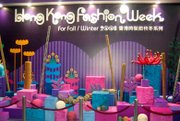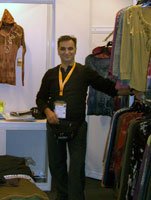Economic Woes Dampen Spirit of Hong Kong Fashion Week
HONG KONG—Up and down the aisles and booths filled with glitzy cocktail dresses, finely knit cashmere sweaters and crayon-colored childrenswear, the feeling inside the Hong Kong Convention and Exhibition Centre was the same: This is going to be a tough year for business.
The headline on the front page of the Asian edition of The Wall Street Journal reiterated that sentiment. quot;Can Asia escape drag of weak U.S.?quot; an article asked. Chinese apparel factories attending the Fall/Winter 2008 Hong Kong Fashion Week, held Jan. 14–17, had the same question, especially when attendance by U.S. buyers was down 2.5 percent to 613 and attendance by European buyers dipped 6.9 percent to 1,779. Total attendance at the show was off 7.2 percent to 23,700.
Factories groused about several economic hurdles in their way. For starters, a new Chinese labor law that goes into effect this year requires employers to give their workers overtime pay and provide them with workers compensation insurance. quot;We never worried before when a worker was hurt,quot; said one Hong Kong–based manufacturer.
In addition, the value of the Chinese yuan compared to the U.S. dollar is about 8 percent to 10 percent higher than it was last year. If that weren’t enough, there is a glut of Chinese apparel factories scrambling for the same business.
quot;A lot of factories have gone bankrupt, especially in south China,quot; said Dicky Kwok, director of Fast Base Enterprises Ltd., a Hong Kong sweater company founded in 1991.
Kwok, whose company has three sweater factories near Dongguan employing 3,000 people, has seen monthly wages steadily rise to about $250 compared with $100 to $150 a few years ago. quot;The new labor law has a lot of extra costs in it,quot; he said.
But he doesn’t dare raise wholesale apparel prices even though the U.S. dollar’s value has slipped. Instead, he is concentrating on elevating productivity by using more computers and fewer people. Kwok, whose company occupied several booths at the Hong Kong show, wasn’t the only Chinese manufacturer singing the financial blues.
Kevin Wu, manager of the garment department at Ningbo NKM Textiles Co. Ltd., a casualwear manufacturer in the middle of China that employs 300 factory workers, said business this market was only quot;so-so.quot; He noticed a distinct lack of U.S. buyers this year who are coping with overloaded inventories, a soft retail market and a blurry picture of what consumers are planning to do. quot;It’s also hard because of quotas,quot; he said. quot;Quotas are a big problem between the United States and China.quot;
He too noted the new labor laws were putting a damper on apparel factories. quot;A lot of factories are going out of business,quot; he confirmed.
Part of the problem, experts say, is that China opened too many apparel factories in 2005, anticipating that quotas would disappear that year. They did for about 11 months. Then the U.S. government imposed safeguard measures, or temporary quotas, on 34 categories of textiles and apparel until the end of 2008. Many are still cautious that some form of quotas will exist after this year.
Contrarian view
While many fretted about how the down-in-the-dumps dollar was hurting their business, Matthew Hekmatniaz was reveling in the weak dollar.
For the first time, the Los Angeles T-shirt maker decided to get a booth at Hong Kong Fashion Week to see if his creatively designed tops made near downtown Los Angeles would be a hit. And they were.
Buyers—mostly from Europe, Malaysia, Singapore and Japan—didn’t blink at his IDI label’s wholesale prices of $9.50 to $34. It didn’t hurt that his contemporary T-shirts that are knitted, dyed and sewn near his offices at 25th Street and Santa Fe Avenue are creatively designed and have an artistic flair. Some have lace, embroidery or stud embellishments, laser-cut PVC designs, flocking or silk-screened images on knobby cotton or garment-dyed fabric. quot;People can’t believe this is made in America,quot; he said. quot;They are hungry for U.S. products.quot;
However, Hekmatniaz, president of H & S Elna International Inc., was only one of two U.S. companies with booths at the vast show, which occupies five enormous halls filled with 1,745 exhibitors. The other was Richie & Stephanie Inc., a Los Angeles lingerie and corset company headed by Richie and Stephanie Park. They do most of their production in China.
Budget constraints
While fewer U.S. buyers attended this year’s Hong Kong Fashion Week, they were still making some purchases with reduced budgets and cautious attitudes.
Sean Shahriar of Paris Dreams, a wholesaler in the Los Angeles Fashion District, likes to come to this show because it has a lot more fashion and new styles than other Chinese shows. He was looking for jackets and sweaters and maybe some fur coats. Fur coats did well for him last year, but a recent anti-fur demonstration during Hong Kong Fashion Week had him thinking twice about that category.
He was buying judiciously because he still had some overhang inventory from last season that wasn’t picked up by the small specialty stores and Mexican middlemen who usually buy his goods. He was also noticing that goods were costing as much as 20 percent to 25 percent higher this year.
quot;Spring and Summer I will be buying very little, and for Winter I’ll be buying the same amount as last year,quot; he said while checking his e-mails at a computer inside the VIP Lounge.
Robert Berg, vice president of purchasing and international sourcing for IQ Apparel Group, which makes uniforms for fast-food companies such as Subway and Sonic Burgers, said he likes to do business at Hong Kong Fashion Week because many factories that can’t afford to show in the United States or can’t get visas to visit are at the show.
His company sources all its hats and aprons, which are non-quota items, in China and about 10 percent of its knit shirts there, too. He was looking for more factories to do production. quot;We’ve pulled most of our factories out of India because it is too expensive,quot; noted the Los Angeles–based businessman.
But China was getting expensive, too. quot;The yuan is raising prices substantially,quot; he said. quot;And then there are the new labor laws.quot;
His company is doing more business with less-developed countries such as Bangladesh and Ethiopia.























